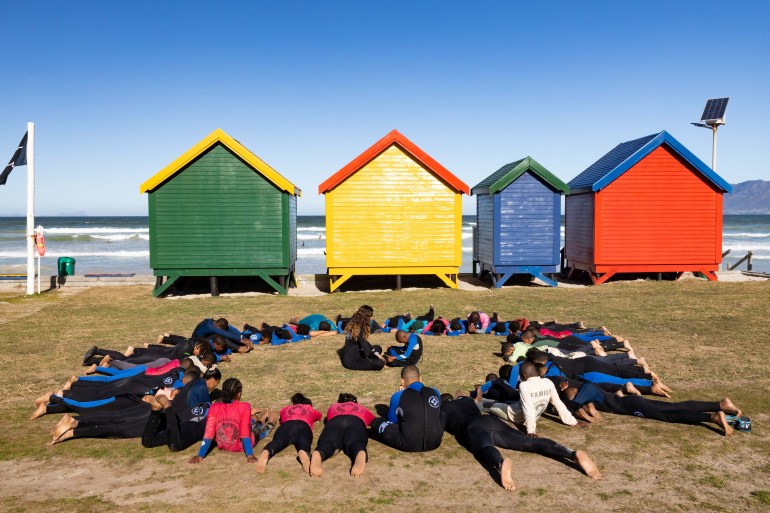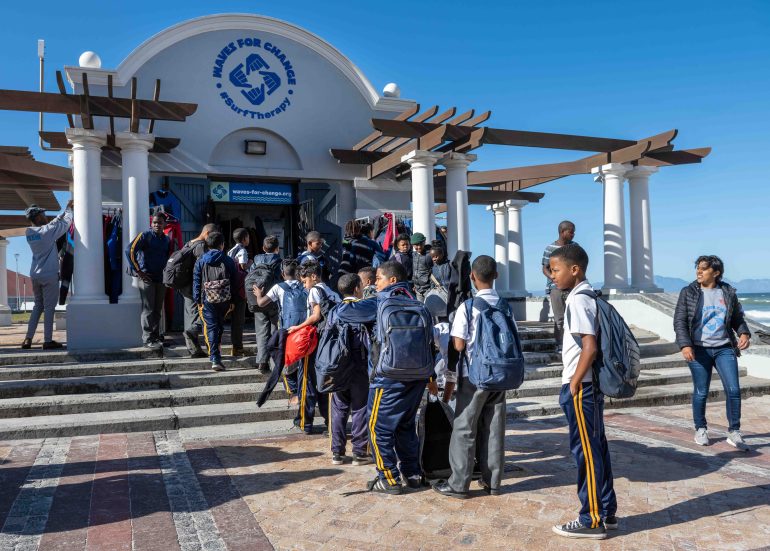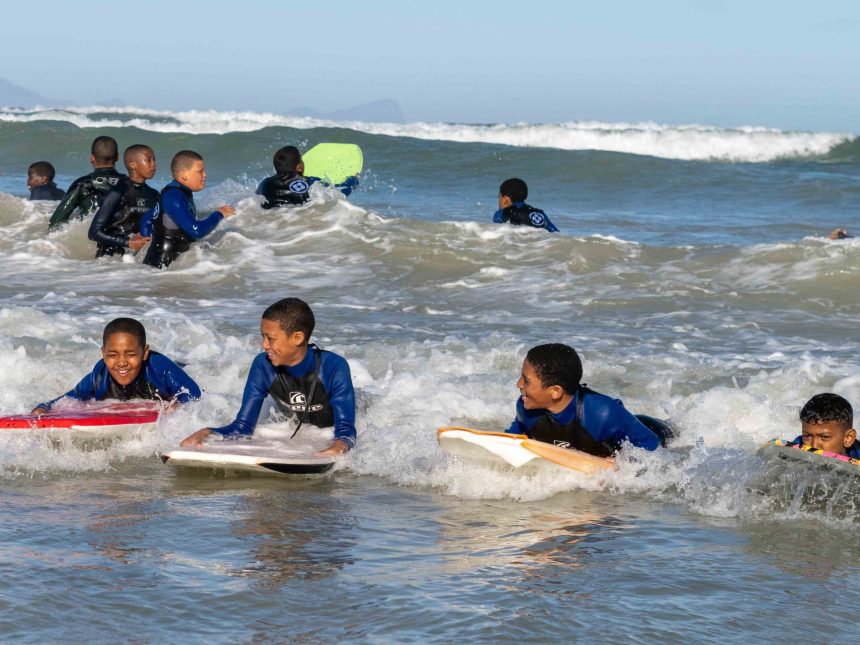[ad_1]
Cape Town, South Africa – It’s a Monday morning and a dozen teenagers from a school for students with autism and related conditions have arrived for their weekly surf therapy session.
Shrieking with glee, one girl envelops her coach in a bear hug. Others are less demonstrative, but the joy on their faces is palpable.
After trading their school uniforms for wetsuits, the students gather on Cape Town’s Muizenberg Beach. A gentle offshore breeze is blowing, and neat rows of waves stack up invitingly towards Cape Point. But before the budding surfers get near the water, they must do a land-based mental health session.
The day’s lesson, coach Bulelani Zelanga informs Al Jazeera, is called Thankful Take 5.
First, the coaches list three things they’re thankful for.
“I am thankful that I found Waves for Change,” Zelanga says. “I am thankful for my support network. And I am thankful that I am still breathing.”
Next the children are taken through a series of breathing exercises and encouraged to think of things they’re thankful for. There’s no pressure to share these with the group, but a few brave souls put up their hands.
“I am thankful for my coaches,” one says. “I am thankful for my parents,” says another.
After about 20 minutes on the beach, it’s time to get into the ocean. Most of the participants are content with splashing around in the waves – many of them can’t swim – but a few try their hand at bodyboarding.
While they play, the coaches are on hand to reassure them – and to encourage them to use their newly acquired breathing skills to cope with the unfamiliar environment.
Zelanga says there’s more actual surfing when the neurotypical kids come in the afternoons, but he also says this isn’t the point: “Therapy comes first, surfing is second.”

And with good reason: Children in South Africa’s townships can frequently experience traumatic events, and there’s a dearth of social workers and psychologists in their communities.
“We aren’t trying to find the next Kelly Slater,” Tim Conibear, the 42-year-old founder and CEO of Waves for Change, tells Al Jazeera, referring to the great United States surfer.
“It’s all about giving kids from difficult backgrounds coping mechanisms and self-regulation strategies. Surfing is just the hook.”
‘Sport provides a shortcut’
Waves for Change works with children aged 11 to 13 who are at high-risk of “toxic stress”, such as those affected by poverty, disabilities, gang violence, or a lack of access to mental health and social services, They are referred by a teacher, nurse or social worker.
For the first eight weeks, the kids simply “teach each other to surf” with the help of their coaches, Conibear says.
“Once we have this tightknit group who all trust each other, we start teaching them mental health skills and coping strategies,” such as self-regulation, sharing and mindful breathing.
Children are transported to and from the beach, and each session ends with a nutritious meal. Kids attend one session per week for a year, after which they can go to an informal surf club on the weekends, which also includes free transport and a meal.
Many kids take part in surf club for five or six years, Conibear says. From there, they can apply for a job as a Waves for Change coach on a two-year contract. Waves for Change encourages coaches to study further and helps them to find a job when their contract expires.
Coaches have gone on to coach at surf resorts in Bali, join the police force, become gym instructors and, of course, work at surf shops near their home beaches.
With five sites in South Africa and one in Liberia, Waves for Change now delivers its surf therapy programme to 2,500 children every week. And this is before you factor in the thousands of children who benefit from the sports therapy programmes run by 35 partner institutions in 10 countries.
“We’ve realised that we can reach tens of thousands of people around the world by making our materials open source and by helping sports clubs of all descriptions to adapt them to suit their exact needs,” Conibear says.
But it wasn’t always this way. When Conibear founded the programme in 2007, it was just him, his VW Golf and four youngsters from Masiphumelele township.
Conibear, who grew up in the United Kingdom, moved to Cape Town in 2006 to work on a winery and then got a job with a surfing travel company.
“When I arrived in South Africa from the UK, the inequality was just so stark. … I wanted to get involved in the community,” he remembers. “I thought: ‘I get a lot out surfing, and I’m sure they will too.’ Simple as that.”
So he put the word out. On the first weekend, there were four people waiting to be picked up. In week two, there were eight. Soon Conibear had replaced his Golf with a Kombi and was spending his Saturdays ferrying up to 50 kids between Masiphumelele and Muizenberg.
Two of those first four surfers – Apish Tshetsha and Bongani Ndlovu – became Waves for Change’s first coaches.
“We’d go surfing and maybe have a hot chocolate afterwards,” Conibear recalls. “I noticed that the kids had formed bonds with the coaches. I don’t speak isiXhosa, but I could see it was a mentoring situation.”
For the first few years, Conibear, Tshetsha and Ndlovu ran the programme on a volunteer basis on weekends only.
Things changed in 2010 when the FIFA World Cup, hosted by South Africa, brought lots of funding opportunities into the sports-for-development sphere – including 10,000 pounds ($12,600) from a British company and 100,000 rand ($5,350) a year from the Laureus Sport for Good Foundation.
“At first I was a bit taken aback,” Conibear laughs. “I didn’t have a clue how we’d spend the money.”
But he quickly realised that bringing Tsetsha and Ndlovu on as salaried employees and running the programme on weekdays would enable him to reach far more kids.

As the programme grew and the team realised it was about far more than teaching kids to surf, Conibear started bringing researchers on board – such as Andy Dawes, an applied developmental psychologist – to refine the programme.
“The fundamental concept of any therapeutic intervention is giving people the opportunity to talk and be listened to,” Conibear says. “The reason we use surfing is that we can do a lot of rapport building in a non-verbal way. In talk therapy, you need to be very skilled to build a relationship. Sport provides a shortcut.”
Jamie Marshall, a research fellow at Edinburgh Napier University who has done extensive research into surf therapy programmes around the world, is impressed by what Conibear and the Waves for Change team have achieved.
“Tim doesn’t have a mental health background. But the whole team has been open to evaluating, learning and refining at every step, and they always listen to the experts,” Marshall says.
A recent study of US navy service members with depression provided the most compelling evidence yet that surf therapy really does work. “Study findings showed improved anxiety, negative affect, psychological resilience and social functioning following program participation,” it determined.
Surf therapy is a very effective tool, but you need to get the fundamentals right, Marshall says, namely harnessing the respite that surfing offers from daily life, carefully curating a safe space and embracing dynamic learning environments.
“Waves For Change ticks all three boxes,” he says. “Getting a physical and emotional safe space right is a huge challenge. … With this kind of young person, if the space is not safe. they will see right through it. If you don’t do the hard work, the programme won’t work.”

‘It gave me a purpose’
The programme still faces challenges, notably with funding and finding the right people to administer it.
Another indicator of the programme’s success is the high number of students who go on to become coaches at Waves for Change, Marshall says.
Case in point is Zelanga, who was referred to Waves For Change in 2011, when he was nine years old.
“I joined Waves For Change without knowing that they were teaching us these coping skills,” he says. “I thought I was just learning to surf.”
Joining the programme helped him to “choose the right friends”, he says. Before joining Waves for Change, he says he was naughty and was both a bully and was bullied.
“Some of my friends from back then are thieves now. Four of them have passed away. Stabbed, all of them.”
Now, he says, he’s learned to control his emotions.
“You can say bad things to my face, and I will just look at you. I won’t do anything,” he says.
Waves For Change has also given him a purpose. Since becoming a coach, he’s taken part in the Laureus Youth Empowerment Through Sport programme, been nominated by the provincial government for a Coaching Excellence Award and completed a diploma in sports administration.
Next year, he plans to do another diploma – in sports management – and after that, he’s hoping to open his own surf academy.
“I’ve been speaking to some students, and I want to start something for 15-, 16-, 17-year-olds,” he says. “… They need direction, and they’re too old for Waves for Change.”
Who needs Kelly Slater when you’re producing people like Bulelani Zelanga?
[ad_2]
Source link









